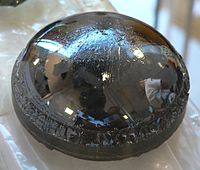
Photo from wikipedia
Superhard materials other than diamond and cubic boron nitride have been actively pursued in the past two decades. Cubic silicon carbide, i.e., β-SiC, is a well-known hard material with typical… Click to show full abstract
Superhard materials other than diamond and cubic boron nitride have been actively pursued in the past two decades. Cubic silicon carbide, i.e., β-SiC, is a well-known hard material with typical hardness <30 GPa. Although nanostructuring has been proven to be effective in enhancing materials' hardness by virtue of the Hall-Petch effect, it remains a significant challenge to improve hardness of β-SiC beyond the superhard threshold of 40 GPa. Here, the fabrication of nanocrystalline β-SiC bulks is reported by sintering nanoparticles under high pressure and high temperature. These β-SiC bulks are densely sintered with average grain sizes down to 10 nm depending on the sintering conditions, and the Vickers hardness increases with decreasing grain size following the Hall-Petch relation. Particularly, the bulk sintered under 25 GPa and 1400 °C shows an average grain size of 10 nm and an asymptotic Vickers hardness of 41.5 GPa. Boosting the hardness of β-SiC over the superhard threshold signifies an important progress in superhard materials research. A broader family of superhard materials is in sight through successful implementation of nanostructuring in other hard materials such as BP.
Journal Title: Small
Year Published: 2022
Link to full text (if available)
Share on Social Media: Sign Up to like & get
recommendations!